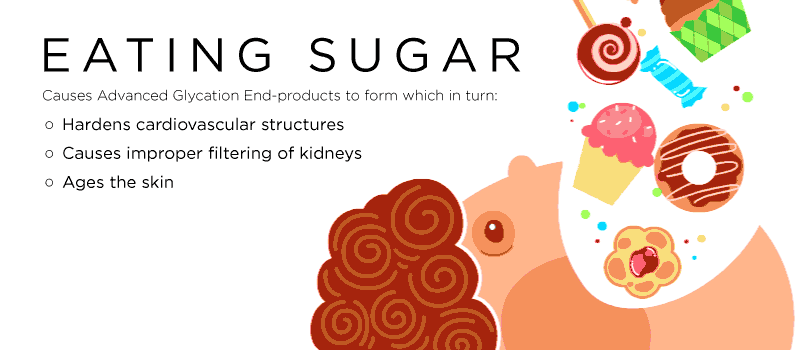I’ve heard it all in nearly eight years of writing FutureDerm: Snails on your face. Fish in your pedicure. But truly the strangest skin care tip that is backed by science doesn’t even belong in your bathroom or even your spa.
The tip is this: Use smaller plates. And don’t get seconds!
Let me explain.
Why Large Portions Destroy Your Skin
The issue is sugar.
Sugar is everywhere. There are many different kinds of sugar: the sugar in milk, the sugar in fruits, the sugar in baked goods, the sugar in vegetables. Everything has sugar. While there are different kinds of sugar, it is important to know that too much of any kind of sugar will trigger your body to release insulin. Insulin is a hormone that delivers glucose to your cells. As sugar enters your bloodstream from the food you eat, your pancreas (and brain) secrete insulin, which transport the glucose out of your blood and into your cells. When you eat too much of any kind of sugar, your pancreas will go into overdrive, producing high levels of insulin to compensate. Over time, this can cause insulin resistance and type 2 diabetes, as well as obesity, heart disease, and even food addiction.

But excess sugar also ages the skin in a very specific process:
1. A blood sugar glycates (attaches to) a protein molecule, forming a Schiff base.
2. The Schiff base either falls apart or forms a more stable product called an Amadori product. Examples of Amadori products include the molecule used to measure blood sugar levels, glycated hemoglobin (Hb1ac), in red blood cells.
3. The Amadori product forms an advanced glycation product (AGE), either directly or through the action of oxoaldehydes, such as methylglyoxyal.
4. The advanced glycation endproduct (AGE) undergoes glycoxidation, a process that is accelerated by the presence of free radicals. This is the super-dangerous part: Through glycoxidation, AGEs cross-link into a second, neighboring protein. These cross links have proven to be responsible, at least in part, for the hardening of cardiovascular structures, improper filtering of the kidneys, and, when the AGE is glucosepane, the hardened, stiffened collagen within aged skin. Cross links of the AGE glucosepane alter the structure of the collagen within the skin and accumulate as you age, progressively making collagen harder and more inflexible.
The average American consumes 150 pounds of sugar each year, which is 100 pounds more per year than in 1900. It’s no wonder that people were slimmer then!
Why Smaller Plates Can Save Your Skin
When you eat small, controlled portions and the right combinations of healthy fats, proteins, and even carbs, your skin will not be overloaded with sugars. Your skin will be protected from the breakdown of sugars and the subsequent formation of advanced glycation endproducts (AGEs) that attach to and deform your skin’s healthy collagen. You will look younger, for longer, because you are not overloading your body with unnecessary sugars.
And if you don’t believe that behavioral change can make a difference, think again. In Slim By Design, leading behavioral economist, food psychologist, and bestselling author Brian Wansink cites cases where he has redesigned people’s homes, offices, and behavioral patterns to lose 20 pounds or more — mostly subconsciously. In addition to eating off of smaller plates, Wansink also advises:
- Eat at high tables, not booths, at restaurants.
- Sit near the door at restaurants, not near the bathrooms or (even worse) the buffet.
- Keep fresh fruit and vegetables on your counter and on your desk.
- Do not keep candy or snacks on your counter or your desk.
- Hide bread and other baked goods in drawers at home.
We make as many as 30,000 decisions each day around food: Full fat, low-fat, no fat. Chocolate, vanilla, strawberry, or 28 other flavors. Fried, steamed, grilled, or broiled. If you want to protect your skin from aging due to too many sugars, it makes sense to stop eating mindlessly. Let your conscious mind take charge now by putting controls on your portions, so your tired, subconscious mind doesn’t have to come dinnertime. By getting rid of any plate over 8 inches in diameter, you will be on your way to better skin. (12 inch plates, be gone! Platters, death to thee!)
But wait…why not just cut carbohydrates altogether?
Unfortunately, the skin’s biology is much too clever to thrive when you cut out an entire food group. Though excess carbohydrates turn to sugar in the bloodstream, you need some carbohydrates, or your collagen goes haywire.
Here’s the evidence: According to a 2005 study, the collagen of patients who were put on the Atkins diet aged faster than the collagen of patients who were not on the diet. Why? Well, when you have too few carbohydrates, your body undergoes a process known as ketosis, where your body burns fats for energy. Unfortunately, when your body is in ketosis, it doubles the amount of methylglyoxal in the body — which, in turn, causes even more collagen-wrecking AGE product formation in the body.
In essence, ketosis causes more AGEs to form. In turn, AGEs bind to your collagen, making it all yucky and brittle.
So you need to eat carbs. You need to stay out of ketosis, or your skin will be bombarded with collagen-deforming AGEs. But you can’t eat too many carbs, or your skin will also be hit by AGEs. Again, the old adage was right: Everything in moderation! Hence, smaller plates.
Bottom Line
For great skin, mounting evidence is showing you need to have fats, proteins, and carbohydrates in moderation. Too much and too little carbohydrate trigger accelerated AGE formation, which in turn deform your skin’s collagen, making it less resilient and supple to the touch. For your best skin, you need to eat fats, proteins, and carbohydrates in moderation. And if behavioral science is any indication, that means small tweaks like eating off of smaller plates will certainly help!





